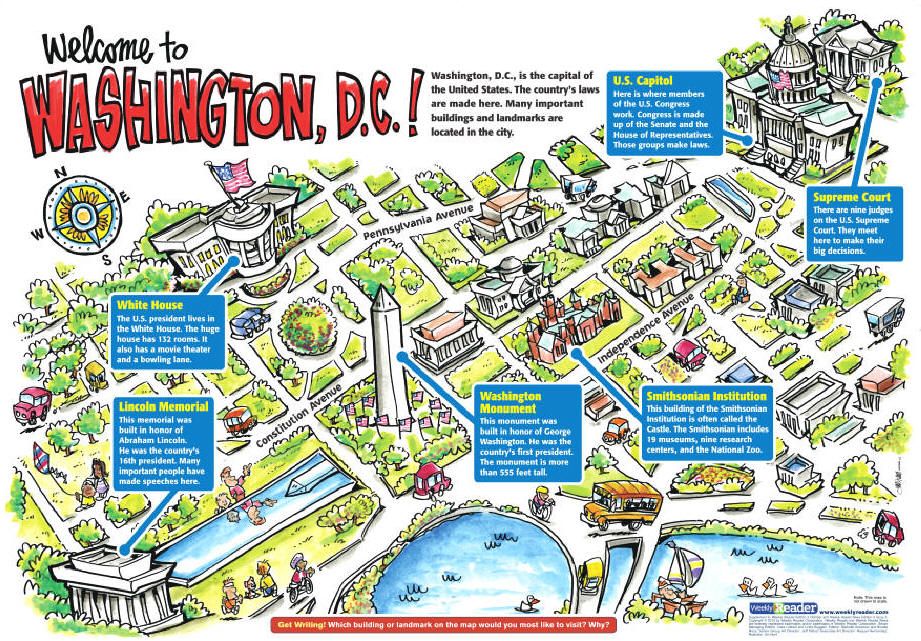DC Trip Planner: Planning a trip to Washington, D.C. can be overwhelming, with its wealth of historical sites, world-class museums, and vibrant neighborhoods. This guide aims to simplify the process, offering a comprehensive approach to crafting the perfect D.C. itinerary, regardless of your travel style or budget. We’ll explore the essential features of a successful trip planner, highlighting key points of interest and providing practical tips to enhance your experience.
From understanding the diverse needs of different travelers to integrating external services for seamless booking and real-time information, we’ll delve into the design, functionality, and content strategy of an effective DC trip planner. We will consider user experience, visual appeal, and the incorporation of user reviews to create a truly engaging and helpful resource for anyone planning a visit to our nation’s capital.
Understanding User Needs for a DC Trip Planner
A successful DC trip planner must cater to a diverse range of travelers, each with unique needs and expectations. Understanding these needs is crucial for designing a user-friendly and effective tool that helps users plan memorable and efficient trips to Washington, D.C.
Different types of travelers utilize trip planners, each with specific motivations and goals influencing their planning process. Analyzing these user profiles helps tailor the planner to meet their individual requirements.
Types of DC Travelers
A DC trip planner should accommodate various traveler profiles. These include families seeking educational and entertaining experiences, couples looking for romantic getaways, history buffs eager to explore significant landmarks, business travelers needing efficient itineraries, and solo adventurers exploring the city at their own pace. Each group prioritizes different aspects of the trip. For example, families prioritize kid-friendly activities and budget-conscious options, while business travelers emphasize convenient locations and efficient transportation.
Traveler Motivations and Goals
The primary motivations driving travelers to Washington, D.C. vary widely. Some seek to immerse themselves in American history and culture, visiting iconic monuments and museums. Others prioritize exploring the city’s vibrant culinary scene or experiencing its diverse neighborhoods. Business travelers often focus on attending conferences or meetings, while others may be visiting family or friends. These diverse goals necessitate a trip planner that can accommodate a range of interests and preferences. A successful planner allows users to customize their itinerary based on their specific motivations.
Trip Lengths and Budgets
Trip lengths and budgets significantly impact trip planning. Short trips (e.g., long weekends) require efficient itineraries focusing on key attractions, while longer trips allow for more in-depth exploration. Budget constraints influence accommodation choices, dining options, and activity selection. A planner should accommodate these variations by offering customizable options, from budget-friendly hostels and affordable eateries to luxury hotels and fine-dining experiences. For example, a three-day trip might focus on the National Mall, while a week-long trip could incorporate day trips to nearby historical sites like Mount Vernon or Annapolis.
User Persona: The History-Buffs Couple
Consider “Sarah” and “Mark,” a couple in their late 30s. They are history enthusiasts with a moderate budget and plan a five-day trip to Washington, D.C. Their primary goal is to explore significant historical sites and museums, with an interest in American political history. They prefer mid-range hotels and a mix of casual and fine dining experiences. They value accurate information and easy-to-navigate itineraries. This persona highlights the need for a planner that offers detailed information on historical sites, integrates museum details, and provides options for various price points. Sarah and Mark represent a significant portion of DC visitors and their needs are a strong foundation for the trip planner’s design.
Essential Features of a DC Trip Planner
A successful DC trip planner needs to go beyond simply listing attractions; it must offer a seamless and personalized experience, catering to diverse travel styles and preferences. This requires a careful selection of core functionalities, intelligent integration of data, and a user-friendly interface. The following sections detail the essential features, compare existing solutions, and outline UI considerations for optimal user experience.
Core Functionalities of a DC Trip Planner
Prioritizing features for a DC trip planner requires considering the user’s journey. A well-designed planner should streamline the planning process, from initial inspiration to on-the-ground navigation. The most crucial functionalities are detailed below.
- Destination Search & Filtering: Allows users to easily find attractions, restaurants, and activities based on keywords, categories (museums, historical sites, parks, etc.), location, price range, accessibility, and user ratings.
- Itinerary Creation & Management: Enables users to create custom itineraries, adding and rearranging activities, specifying time slots, and setting reminders. This should include options for importing and exporting itineraries.
- Map Integration: A fully integrated map displaying all planned activities, with directions and real-time traffic information. This should ideally allow users to easily adjust itineraries based on travel times.
- Transportation Options: Provides information on various transportation modes (metro, bus, taxi, ride-sharing) with integrated fare estimates and scheduling tools.
- Accommodation Booking Integration: Allows users to search and book accommodations directly within the planner, displaying options based on location, price, and reviews.
- Recommendation Engine: Suggests activities and attractions based on user preferences, travel style, and time constraints. This could be based on collaborative filtering or other recommendation algorithms.
- Offline Functionality: Ensures key features like map access and itinerary viewing are available offline, crucial for areas with limited connectivity.
Comparison of Existing Trip Planning Tools
Several websites and apps offer trip planning features, each with strengths and weaknesses. Direct comparison helps identify best practices and areas for improvement in a new DC-specific planner. For instance, while Google Trips (now discontinued) excelled at itinerary organization, it lacked the depth of local information found in dedicated city guides. Similarly, TripAdvisor provides extensive reviews but may fall short in itinerary management capabilities.
Feature Comparison Table
| Destination | Feature | Pros | Cons |
|---|---|---|---|
| Google Maps | Navigation, Location Search | Excellent navigation, real-time traffic, wide coverage | Limited itinerary planning features, no integrated booking |
| TripAdvisor | Reviews, Attraction Information | Extensive user reviews, comprehensive attraction database | Weak itinerary planning, booking can be disjointed |
| Roadtrippers | Road Trip Planning | Specialized for road trips, integrates points of interest along routes | Less suitable for city-focused trips, limited public transport integration |
| Rome2rio | Multimodal Transportation | Comprehensive transportation options, including schedules and prices | Limited itinerary management, lacks attraction details |
UI Design Considerations
A user-friendly interface is paramount. The design should be intuitive, visually appealing, and accessible across various devices. Key considerations include:
- Clear Visual Hierarchy: Important information should be easily identifiable, using appropriate font sizes, colors, and spacing.
- Intuitive Navigation: Users should be able to easily find what they need without extensive searching. A clear menu structure and search functionality are essential.
- Responsive Design: The planner should adapt seamlessly to different screen sizes and devices (smartphones, tablets, desktops).
- Accessibility Features: The design should adhere to accessibility guidelines, ensuring usability for users with disabilities.
- Personalized Experience: The planner should adapt to user preferences, offering customizable settings and personalized recommendations.
Content Strategy for a DC Trip Planner
A successful DC trip planner requires a well-defined content strategy that caters to diverse visitor interests and provides comprehensive information. This strategy involves carefully selecting points of interest, structuring data for easy navigation, and offering detailed descriptions to enhance the user experience. The goal is to empower users to plan personalized trips that align with their preferences and time constraints.
Essential Points of Interest in Washington, D.C.
This section outlines key attractions categorized for convenient planning. The categorization allows users to easily filter and select destinations based on their interests.
- Museums: National Air and Space Museum, National Museum of Natural History, National Gallery of Art, National Museum of American History, Smithsonian National Museum of African American History and Culture.
- Monuments & Memorials: Lincoln Memorial, Washington Monument, Jefferson Memorial, World War II Memorial, Martin Luther King, Jr. Memorial.
- Historical Sites: Ford’s Theatre, National Archives Museum, The White House (exterior viewing), Capitol Building (exterior viewing), Arlington National Cemetery.
- Other Attractions: National Mall, International Spy Museum, National Zoo, Georgetown Waterfront, Kennedy Center.
Detailed Descriptions of Significant Landmarks
Providing in-depth information on key landmarks enriches the user experience and helps them make informed decisions about their itinerary.
- Lincoln Memorial: This iconic monument, dedicated in 1922, features a massive seated statue of Abraham Lincoln. Its neoclassical design and powerful symbolism make it a must-see. The memorial’s location on the National Mall offers breathtaking views of the reflecting pool and Washington Monument. The inscription of Lincoln’s Gettysburg Address and Second Inaugural Address adds to its historical significance.
- Washington Monument: A towering obelisk, the Washington Monument stands as a tribute to the first President of the United States. Completed in 1884, it offers panoramic views of the city from its observation deck (reservations are usually required). The monument’s construction spanned decades, reflecting the challenges and perseverance of its creators.
- National Air and Space Museum: This Smithsonian museum houses an unparalleled collection of aircraft and spacecraft, showcasing the history of flight and space exploration. From the Wright brothers’ 1903 Flyer to the Apollo 11 command module, the exhibits offer a captivating journey through aviation and space achievements. Interactive displays and informative panels make it engaging for all ages.
- National Mall: The National Mall is the heart of Washington, D.C., a vast green space stretching from the Capitol Building to the Lincoln Memorial. It serves as a backdrop for many of the city’s most important monuments and museums, offering a space for reflection and recreation. The Mall’s design and layout are significant aspects of the city’s urban planning.
- National Museum of Natural History: This Smithsonian museum houses an extensive collection of natural history specimens, including dinosaur fossils, gems, and cultural artifacts from around the world. Its engaging exhibits cover diverse topics, from the evolution of life on Earth to the diversity of cultures. The museum’s research and educational programs contribute significantly to scientific understanding.
Sample Three-Day Washington, D.C. Itinerary
A sample itinerary provides users with a starting point for planning their trip, allowing them to customize it based on their interests and preferences.
Day 1: Monuments and Memorials: Begin at the Lincoln Memorial, walk along the Reflecting Pool to the Washington Monument, and visit the World War II Memorial. In the afternoon, explore the Jefferson Memorial and consider a visit to the Tidal Basin.
Day 2: Museums and History: Spend the morning at the National Air and Space Museum, followed by the National Museum of Natural History. In the afternoon, explore the National Archives Museum and consider a visit to Ford’s Theatre.
Day 3: Other Attractions and Exploration: Visit the International Spy Museum or the National Zoo, depending on your interests. Spend the afternoon exploring Georgetown, enjoying the waterfront and its charming streets. Consider a performance at the Kennedy Center in the evening.
Visual Elements and User Experience
A compelling visual style is crucial for a successful DC trip planner. It needs to reflect the city’s grandeur, history, and vibrancy while maintaining a user-friendly interface. The design should be clean, intuitive, and easily navigable, ensuring a positive user experience for all visitors, regardless of their technological proficiency.
The visual design should evoke the feeling of exploring Washington, D.C. This can be achieved through a combination of carefully selected imagery, a consistent color palette, and a well-structured layout. The overall aesthetic should be modern yet classic, reflecting the city’s blend of historical significance and contemporary dynamism.
Ideal Visual Style
The ideal visual style for a DC trip planner would incorporate a sophisticated yet approachable aesthetic. A color palette drawing inspiration from the city’s landmarks – muted grays and whites representing the monuments, punctuated by pops of cherry blossom pink or the deep red of brick buildings – would be effective. High-quality, professional photography would be paramount, showcasing the city’s diverse offerings. The typography should be clean and legible, using a mix of serif and sans-serif fonts to create visual hierarchy and avoid visual fatigue. The overall design should be responsive, adapting seamlessly to various screen sizes (desktops, tablets, and smartphones).
Itinerary Builder Mock-up
Imagine a webpage dedicated to itinerary building. The page is divided into three clear sections. The left section features a map of Washington D.C. with interactive markers representing points of interest. Clicking a marker displays information about that location, including images and a brief description. The center section is the main itinerary builder. Users can drag and drop points of interest from the map or a searchable list into their itinerary. Each item in the itinerary displays its name, time, and a small image. Users can adjust the timing and order of events easily via drag-and-drop functionality. The right section displays a summary of the itinerary, including total travel time and a visual representation of the planned route on the map. The overall design is clean and uncluttered, allowing users to focus on building their perfect DC itinerary.
High-Quality Images and User Experience Enhancement
High-quality images are indispensable for enhancing the user experience. They serve as the primary visual representation of the city, inspiring users and conveying the unique atmosphere of Washington, D.C. Images should be sharp, well-lit, and accurately represent the location or event. Poor-quality or blurry images can detract from the overall experience and negatively impact user engagement. Images should also be optimized for fast loading times to avoid frustrating delays.
Visually Appealing Images Showcasing Washington, D.C.
A photograph of the Tidal Basin during peak cherry blossom season would showcase the city’s springtime beauty. The delicate pink blossoms contrasted against the serene water and the backdrop of the Jefferson Memorial would create a captivating image. A nighttime shot of the Washington Monument, illuminated against the dark sky, would highlight the monument’s grandeur and provide a different perspective on a familiar landmark. Images depicting the vibrant street life of Georgetown or Adams Morgan, showcasing diverse architecture and bustling crowds, would capture the city’s energetic atmosphere. Finally, a panoramic view of the National Mall, encompassing the various monuments and museums, would provide a comprehensive visual representation of the city’s historical significance.
Closing Notes
Ultimately, a successful DC Trip Planner needs to be more than just a list of attractions; it needs to be a personalized guide that caters to individual needs and preferences. By carefully considering user needs, incorporating essential features, and leveraging high-quality visuals, a well-designed trip planner can transform a potentially stressful experience into an enjoyable and memorable journey through the heart of American history and culture. We hope this overview provides a solid foundation for developing a truly exceptional DC trip planning tool.




